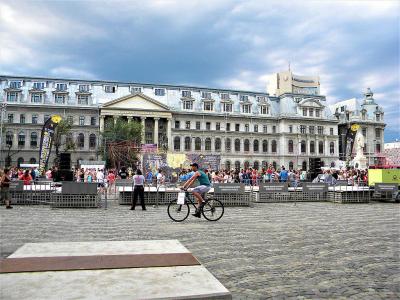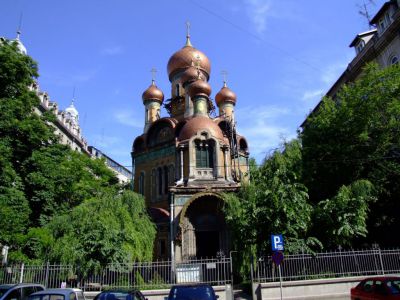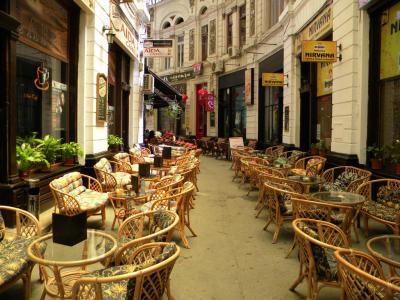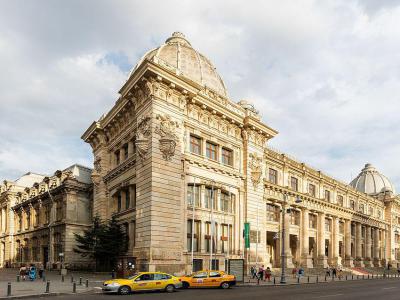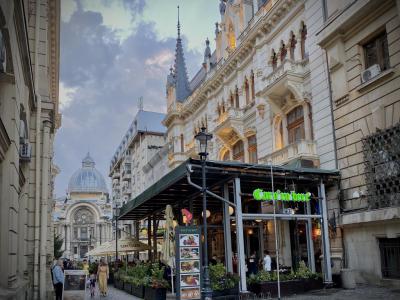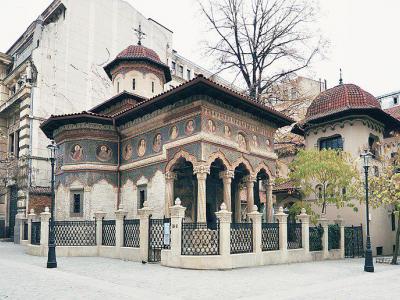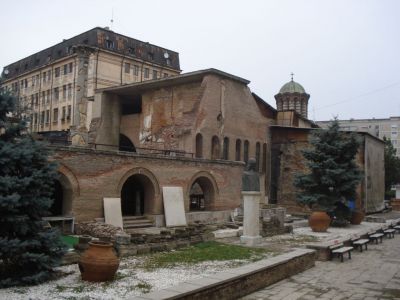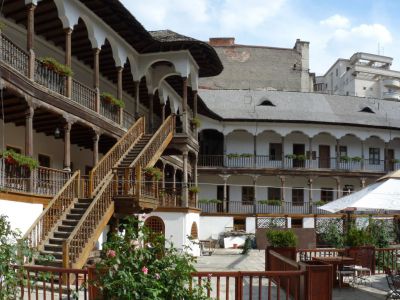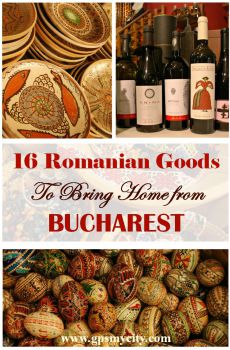Old Town Walking Tour (Self Guided), Bucharest
The Historical Center of Bucharest, or the Old Town, as the locals habitually refer to it, is one of the most beloved and attractive areas in the Romanian capital. The neighborhood is really beautiful a place to visit, and you can walk into it pretty much from anywhere in central Bucharest. Ion Constantin Brătianu Boulevard crosses the historic heart of the city from Piata Universitate (University Square), in the north, to Piata Unirii (Union Square) in the south, splitting it into two almost equal parts.
Steeped in a mix of neoclassical and neo-baroque architecture, the grand Old Town area is an open-air museum, featuring excavated medieval ruins of Curtea Veche, the former court of infamous ruler Vlad the Impaler, and the National Museum of Romanian History showcasing religious icons and royal treasures in a former palace.
Not far from University Square stands the Russian Orthodox Church of St. Nicholas, commissioned in 1905. Further afield, tucked away between taller buildings is yet another, more ancient, 18th-century church of the Stavropoleos Convent.
Hanul cu Tei (The Linden Tree Inn), on Strada Lipscani (Lipscani street), is one of the few historic inns still existing in Bucharest. Having largely retained its original appearance since 1833, the Inn hosts one of the biggest art galleries in the country, featuring vintage furniture, tapestries, rugs, paintings, and other artifacts.
Another historical inn – Hanul lui Manuc (Manuc's Inn) – is the oldest operating hotel in the city. It also houses a popular restaurant, several bars, a coffee-house, stores, and an extensive bar.
If you care to wander through the cobbled lanes of Bucharest’s Old Town and explore its attractions in more detail, do it in your good time and at your own pace with the help of our self-guided walking tour and enjoy yourself!
Steeped in a mix of neoclassical and neo-baroque architecture, the grand Old Town area is an open-air museum, featuring excavated medieval ruins of Curtea Veche, the former court of infamous ruler Vlad the Impaler, and the National Museum of Romanian History showcasing religious icons and royal treasures in a former palace.
Not far from University Square stands the Russian Orthodox Church of St. Nicholas, commissioned in 1905. Further afield, tucked away between taller buildings is yet another, more ancient, 18th-century church of the Stavropoleos Convent.
Hanul cu Tei (The Linden Tree Inn), on Strada Lipscani (Lipscani street), is one of the few historic inns still existing in Bucharest. Having largely retained its original appearance since 1833, the Inn hosts one of the biggest art galleries in the country, featuring vintage furniture, tapestries, rugs, paintings, and other artifacts.
Another historical inn – Hanul lui Manuc (Manuc's Inn) – is the oldest operating hotel in the city. It also houses a popular restaurant, several bars, a coffee-house, stores, and an extensive bar.
If you care to wander through the cobbled lanes of Bucharest’s Old Town and explore its attractions in more detail, do it in your good time and at your own pace with the help of our self-guided walking tour and enjoy yourself!
How it works: Download the app "GPSmyCity: Walks in 1K+ Cities" from Apple App Store or Google Play Store to your mobile phone or tablet. The app turns your mobile device into a personal tour guide and its built-in GPS navigation functions guide you from one tour stop to next. The app works offline, so no data plan is needed when traveling abroad.
Old Town Walking Tour Map
Guide Name: Old Town Walking Tour
Guide Location: Romania » Bucharest (See other walking tours in Bucharest)
Guide Type: Self-guided Walking Tour (Sightseeing)
# of Attractions: 13
Tour Duration: 2 Hour(s)
Travel Distance: 1.9 Km or 1.2 Miles
Author: DanaOffice
Sight(s) Featured in This Guide:
Guide Location: Romania » Bucharest (See other walking tours in Bucharest)
Guide Type: Self-guided Walking Tour (Sightseeing)
# of Attractions: 13
Tour Duration: 2 Hour(s)
Travel Distance: 1.9 Km or 1.2 Miles
Author: DanaOffice
Sight(s) Featured in This Guide:
- University Square
- Bucharest Russian Church
- Museum of the National Bank of Romania
- Macca-Villacrosse Passage
- National Museum of Romanian History
- Caru’ cu Bere (The Beer Wagon)
- Stavropoleos Convent
- Smardan Street
- Curtea Veche (Old Court)
- Biserica Curtea Veche (Old Court Church)
- Manuc's Inn
- Hanul cu Tei (The Linden Tree Inn)
- Lipscani Street
1) University Square
University Square (Piata Universitatii) is one of the city’s most vibrant and historically significant public spaces. Located at the heart of downtown Bucharest, this bustling square serves as both a major transportation hub-where two metro lines meet-and a central gathering spot. For tourists, it’s a perfect starting point to get a feel for the city's energy, architectural contrasts, and layered past. From here, you can explore surrounding landmarks on foot, including the National Theatre and the University of Bucharest.
Designed in a semi-circular shape, University Square is framed by wide, pedestrian-friendly boulevards and dotted with fountains and statues. It’s a lovely spot to relax and watch the flow of city life-whether locals heading to work, street artists performing, or vendors offering refreshments. By day, the square is bright and lively; by night, it becomes a glowing cultural crossroads, with nearby cafés and restaurants that spill onto the sidewalks, inviting you to linger over a coffee or a glass of wine.
Beyond its aesthetic charm, University Square is steeped in modern Romanian history. In the late 20th century, and again in 1990, it served as the epicenter for mass demonstrations that helped shape the course of Romania’s democratic transition. The space has since evolved into a place not only of daily urban life but also of civic memory, where plaques and public art commemorate important events and figures. Tourists interested in social history will appreciate the subtle reminders of Romania’s journey toward freedom.
For visitors, the convenience of transport, rich architectural backdrop, and palpable sense of history make University Square a must-see destination. Whether you’re here to map out your city itinerary or simply soak in the urban atmosphere, this square offers a perfect blend of convenience, culture, and storytelling.
Designed in a semi-circular shape, University Square is framed by wide, pedestrian-friendly boulevards and dotted with fountains and statues. It’s a lovely spot to relax and watch the flow of city life-whether locals heading to work, street artists performing, or vendors offering refreshments. By day, the square is bright and lively; by night, it becomes a glowing cultural crossroads, with nearby cafés and restaurants that spill onto the sidewalks, inviting you to linger over a coffee or a glass of wine.
Beyond its aesthetic charm, University Square is steeped in modern Romanian history. In the late 20th century, and again in 1990, it served as the epicenter for mass demonstrations that helped shape the course of Romania’s democratic transition. The space has since evolved into a place not only of daily urban life but also of civic memory, where plaques and public art commemorate important events and figures. Tourists interested in social history will appreciate the subtle reminders of Romania’s journey toward freedom.
For visitors, the convenience of transport, rich architectural backdrop, and palpable sense of history make University Square a must-see destination. Whether you’re here to map out your city itinerary or simply soak in the urban atmosphere, this square offers a perfect blend of convenience, culture, and storytelling.
2) Bucharest Russian Church
Nestled just off University Square in the heart of Bucharest’s historic center, the Saint Nicholas Russian Church (Biserica Sfantul Nicolae – Rusa) is a striking gem of early 20th-century Russian Orthodox architecture. Built between 1905 and 1909 at the behest of Russian Ambassador Mikhail Nikolaevich Giers and funded by Tsar Nicholas II, this church was originally intended for the Russian diplomatic community and expatriates living in Romania at the time.
The church is a rare example of Russian Revival style in Romania, featuring seven gilded onion domes perched atop pink-and-yellow brick façades. The domes, eye-catching with their traditional motifs and crowned by golden Orthodox crosses, were designed in the Neo-Russian style, tinged with the Art Nouveau spirit that was prevalent in Europe at the turn of the century. Entering through an elaborately carved stone portal, you step into a serene sanctuary that dazzles with ornate iconography and rich décor.
Inside, the iconostasis is a masterpiece in its own right-hand-carved in Moscow and coated in gold leaf, modeled after the one in the Archangel Cathedral of the Kremlin. Russian painter Vasiliev originally adorned the interior walls with vivid oil frescoes, later restored by Anatolie Cudinov in the mid-20th century. The result is an immersive visual journey, blending Byzantine influences of Mount Athos with the vibrant palette of Russian ecclesiastical art.
Today, the church serves a dual purpose. Since 1992, it has functioned as the University of Bucharest’s chapel, earning the affectionate name of the “Students’ Church.” Open to anyone seeking reflection, culture, or spirituality, it blends religious services with musical and artistic events, creating a warm, welcoming atmosphere for both locals and tourists. Whether you’re drawn by its architectural grandeur or its peaceful interior, the Russian Church offers a luminous insight into Bucharest’s multicultural heritage and spiritual life.
The church is a rare example of Russian Revival style in Romania, featuring seven gilded onion domes perched atop pink-and-yellow brick façades. The domes, eye-catching with their traditional motifs and crowned by golden Orthodox crosses, were designed in the Neo-Russian style, tinged with the Art Nouveau spirit that was prevalent in Europe at the turn of the century. Entering through an elaborately carved stone portal, you step into a serene sanctuary that dazzles with ornate iconography and rich décor.
Inside, the iconostasis is a masterpiece in its own right-hand-carved in Moscow and coated in gold leaf, modeled after the one in the Archangel Cathedral of the Kremlin. Russian painter Vasiliev originally adorned the interior walls with vivid oil frescoes, later restored by Anatolie Cudinov in the mid-20th century. The result is an immersive visual journey, blending Byzantine influences of Mount Athos with the vibrant palette of Russian ecclesiastical art.
Today, the church serves a dual purpose. Since 1992, it has functioned as the University of Bucharest’s chapel, earning the affectionate name of the “Students’ Church.” Open to anyone seeking reflection, culture, or spirituality, it blends religious services with musical and artistic events, creating a warm, welcoming atmosphere for both locals and tourists. Whether you’re drawn by its architectural grandeur or its peaceful interior, the Russian Church offers a luminous insight into Bucharest’s multicultural heritage and spiritual life.
3) Museum of the National Bank of Romania
The Museum of the National Bank of Romania offers a captivating dive into the nation’s financial and architectural heritage. Housed within the historic New BNR Palace, the building dates back to the World War II era (1937–1944) and was designed in the elegant classical style with rationalist influences by architects Ion Davidescu, Radu Dudescu, and N. Cretoiu. Inside, visitors are greeted by grand marble halls, monumental granite staircases, and imposing Corinthian columns-testament to the Neoclassical charm that marks Bucharest’s cityscape.
The museum’s rich numismatic collection spans over two and a half millennia, featuring rare artifacts such as the oldest coin minted in Romanian territory, the smallest-ever Romanian paper money, and an impressive assembly of gold coins, bars, and medals. Highlights include the chance to touch a 13‑kilo gold bar and examine original minting tools and dies-an immersive experience for those fascinated by the evolution of money.
Tours are free but must be booked in advance, with guided visits provided by knowledgeable staff-usually lasting around an hour and rich in anecdotes linking Romania’s monetary history to its broader cultural narrative. The museum operates on weekdays only, and spaces fill up quickly, so booking early is recommended.
Whether you’re a history buff, a fan of monumental architecture, or simply curious about Romania’s economic story, the Museum of the National Bank offers a thoughtfully curated, free-of-charge educational experience in a beautifully preserved setting. It’s a perfect complement to a stroll through Bucharest’s historic center, just steps away from the Lipscani pedestrian district.
The museum’s rich numismatic collection spans over two and a half millennia, featuring rare artifacts such as the oldest coin minted in Romanian territory, the smallest-ever Romanian paper money, and an impressive assembly of gold coins, bars, and medals. Highlights include the chance to touch a 13‑kilo gold bar and examine original minting tools and dies-an immersive experience for those fascinated by the evolution of money.
Tours are free but must be booked in advance, with guided visits provided by knowledgeable staff-usually lasting around an hour and rich in anecdotes linking Romania’s monetary history to its broader cultural narrative. The museum operates on weekdays only, and spaces fill up quickly, so booking early is recommended.
Whether you’re a history buff, a fan of monumental architecture, or simply curious about Romania’s economic story, the Museum of the National Bank offers a thoughtfully curated, free-of-charge educational experience in a beautifully preserved setting. It’s a perfect complement to a stroll through Bucharest’s historic center, just steps away from the Lipscani pedestrian district.
4) Macca-Villacrosse Passage
Nestled in the heart of historic Lipscani district, the Macca‑Villacrosse Passage is a captivating 19th‑century gem offering a unique blend of elegance, architectural innovation, and bohemian flair. Constructed in 1891 by architect Felix Xenopol, this graceful arcade spans between Victory Avenue (Calea Victoriei) and Lipscani Street. What sets it apart is its distinctive fork‑shaped design, created after a hotel in the center resisted acquisition, resulting in two glass‑covered wings that elegantly arch around the building.
Originally a luxurious shopping arcade and Bucharest’s first Stock Exchange, the Passage hosted the city's primary financial hub before it relocated, earning it the unofficial title of the first “luxury mall” in Bucharest. During the Communist era (1950–1990), it was renamed the “Jewelry Passage” (Pasajul Bijuteria), and though that title fell out of favour, traces of its glittering past still linger in the ornate façades and boutique atmosphere.
Today, Macca‑Villacrosse has been revitalized as a lively cultural and social hub. Sheltered under a luminous yellow glass canopy, the arcade is lined with convivial cafés, cozy bistros, stylish wine bars, and themed spots like “The Valley of the Kings,” an Arabic‑Egyptian bar highlighting the city’s modern-day cosmopolitan tastes. Wander through daylight or evening ambiance, and you can still sense the passage’s storied elegance mingled with current urban energy.
For tourists seeking a memorable stop between sightseeing in the Old Town and along Calea Victoriei, the Passage offers a perfect blend of historical character and contemporary charm. Whether savouring a coffee, admiring intricate architecture, or strolling through shaded arcade corridors, you’ll be stepping into a living time capsule that captures Bucharest’s eclectic spirit.
Originally a luxurious shopping arcade and Bucharest’s first Stock Exchange, the Passage hosted the city's primary financial hub before it relocated, earning it the unofficial title of the first “luxury mall” in Bucharest. During the Communist era (1950–1990), it was renamed the “Jewelry Passage” (Pasajul Bijuteria), and though that title fell out of favour, traces of its glittering past still linger in the ornate façades and boutique atmosphere.
Today, Macca‑Villacrosse has been revitalized as a lively cultural and social hub. Sheltered under a luminous yellow glass canopy, the arcade is lined with convivial cafés, cozy bistros, stylish wine bars, and themed spots like “The Valley of the Kings,” an Arabic‑Egyptian bar highlighting the city’s modern-day cosmopolitan tastes. Wander through daylight or evening ambiance, and you can still sense the passage’s storied elegance mingled with current urban energy.
For tourists seeking a memorable stop between sightseeing in the Old Town and along Calea Victoriei, the Passage offers a perfect blend of historical character and contemporary charm. Whether savouring a coffee, admiring intricate architecture, or strolling through shaded arcade corridors, you’ll be stepping into a living time capsule that captures Bucharest’s eclectic spirit.
5) National Museum of Romanian History
The National Museum of Romanian History resides in the grand former Postal Services Palace-an architectural gem built between 1894 and 1899 in an eclectic style by Alexandru Savulescu. Established between 1970 and officially opened in 1972, the museum spans over 8,000 square meters with approximately 60 exhibition rooms, making it Romania’s preeminent institution of history and archaeology. As you approach the grand entrance-lined with Doric columns and crowned by a high central dome-you can’t help but sense the cultural importance awaiting within.
Inside, the museum weaves a rich narrative of Romania’s journey from prehistoric communities through Dacian tribes, Roman conquest, medieval principalities, and the modern nation-state. The permanent exhibition “Historical Treasure” showcases over 3,000 precious objects-gold, silver, regal jewelry, and coins-many of which were repatriated from abroad. Key highlights include the Dacian gold bracelets, treasures from Pietroasele, and the Romanian Crown Jewels, including royal crowns that reflect both craftsmanship and royal heritage.
One of the museum’s most visually striking installations is the life‑size plaster copy of Trajan’s Column, complete with intricate relief work depicting the Dacian Wars. Housed within a dedicated lapidarium, this faithful reproduction offers a captivating, close‑range view of this Roman monument. Other notable exhibits include royal artifacts, medieval armaments, numismatic collections, philatelic archives from the postal palace days, and documents from pivotal figures in Romanian history.
For visitors, the museum offers a compelling and educational experience. It is open Wednesday to Sunday, and features rotating temporary exhibitions, educational workshops, and family‑friendly programming. As Romania’s top historical museum, the National Museum of Romanian History offers travelers an immersive journey through the nation’s cultural legacy-whether it’s ancient jewelry, medieval relics, royal regalia, or Roman grandeur, it’s all here, waiting to be discovered.
Inside, the museum weaves a rich narrative of Romania’s journey from prehistoric communities through Dacian tribes, Roman conquest, medieval principalities, and the modern nation-state. The permanent exhibition “Historical Treasure” showcases over 3,000 precious objects-gold, silver, regal jewelry, and coins-many of which were repatriated from abroad. Key highlights include the Dacian gold bracelets, treasures from Pietroasele, and the Romanian Crown Jewels, including royal crowns that reflect both craftsmanship and royal heritage.
One of the museum’s most visually striking installations is the life‑size plaster copy of Trajan’s Column, complete with intricate relief work depicting the Dacian Wars. Housed within a dedicated lapidarium, this faithful reproduction offers a captivating, close‑range view of this Roman monument. Other notable exhibits include royal artifacts, medieval armaments, numismatic collections, philatelic archives from the postal palace days, and documents from pivotal figures in Romanian history.
For visitors, the museum offers a compelling and educational experience. It is open Wednesday to Sunday, and features rotating temporary exhibitions, educational workshops, and family‑friendly programming. As Romania’s top historical museum, the National Museum of Romanian History offers travelers an immersive journey through the nation’s cultural legacy-whether it’s ancient jewelry, medieval relics, royal regalia, or Roman grandeur, it’s all here, waiting to be discovered.
6) Caru’ cu Bere (The Beer Wagon)
The Beer Wagon (Caru’ cu Bere) is one of Bucharest’s most iconic and beloved destinations-a living testament to Romanian hospitality and craftsmanship. Originally opened as a brewery in 1879 by Transylvanian entrepreneurs Ion Cabasan and his nephews from Cata, it evolved into the grand restaurant we know today in 1899 under Nicolae Mircea’s vision. Designed by Austrian architect Siegfrid Kofczinsky in Neo‑Gothic style, its vaulted ceilings, stained glass, ornate woodwork, mosaics, and frescoes make it a stunning example of German Romanticism in the heart of the Lipscani (Old Town) district.
This historic monument draws more than 2,500 guests daily, offering a vibrant blend of Romanian culinary tradition and convivial atmosphere. Inside, guests can savour the legendary homemade beer, made using the Mircea family’s century-old recipe, alongside hearty Romanian favourites, such as mititei, the grilled minced meat rolls first served here in 1902. Whether you're sipping a cold pint or feasting under the glow of artful stained glass, the Beer Wagon transports you back to Bucharest’s golden age.
A visit is about more than food and drink-it’s a lively cultural experience. Expect live music (traditional folk and popular tunes), boisterous tables, and a convivial mix of locals and tourists filling the two-storey hall. It’s an ideal spot for a hearty lunch, festive dinner, or late-evening gathering. Located on Stavropoleos Street, it anchors the historic district and complements a stroll through Lipscani’s charming lanes.
For tourists seeking an authentic taste of Bucharest’s soul, the Beer Wagon offers an immersive journey, combining striking architectural beauty, rich history, and traditional Romanian hospitality. Be sure to reserve ahead, as its popularity is well deserved and the atmosphere is irresistible.
This historic monument draws more than 2,500 guests daily, offering a vibrant blend of Romanian culinary tradition and convivial atmosphere. Inside, guests can savour the legendary homemade beer, made using the Mircea family’s century-old recipe, alongside hearty Romanian favourites, such as mititei, the grilled minced meat rolls first served here in 1902. Whether you're sipping a cold pint or feasting under the glow of artful stained glass, the Beer Wagon transports you back to Bucharest’s golden age.
A visit is about more than food and drink-it’s a lively cultural experience. Expect live music (traditional folk and popular tunes), boisterous tables, and a convivial mix of locals and tourists filling the two-storey hall. It’s an ideal spot for a hearty lunch, festive dinner, or late-evening gathering. Located on Stavropoleos Street, it anchors the historic district and complements a stroll through Lipscani’s charming lanes.
For tourists seeking an authentic taste of Bucharest’s soul, the Beer Wagon offers an immersive journey, combining striking architectural beauty, rich history, and traditional Romanian hospitality. Be sure to reserve ahead, as its popularity is well deserved and the atmosphere is irresistible.
7) Stavropoleos Convent (must see)
Stavropoleos Convent (Manastirea Stavropoleos) is a hidden treasure tucked away on a quiet lane in Bucharest’s bustling Old Town. Founded in 1724 by Greek archimandrite Ioanichie Stratonikeas under Prince Nicolae Mavrocordatos, the convent-with its cobblestone courtyard and peaceful atmosphere-offers a serene contrast to the energetic cafés and shops just steps away. The name Stavropoleos is derived from the Greek “Stauropolis,” meaning “City of the Cross,” a poetic reminder of the convent's spiritual focus.
Architecturally, the church and remaining convent buildings showcase the exquisite Brancovenesc style-an iconic synthesis of Byzantine, Ottoman, Italian Renaissance, and local influences. You’ll notice its intricately carved stone portico, trilobate arches, floral motifs, and framed religious medallions adorning the facade. Inside, the intimate space is rich with stunning frescoes, gilded icons, and an atmosphere heavy with incense and devotion. Its survival through earthquakes, secularization, and the Ceaușescu era makes visiting feel like stepping back into early 18th-century Bucharest.
Beyond its visual beauty, Stavropoleos is a living center for Orthodox spirituality and cultural heritage. The convent is active with nuns and priests who continue its mission through a renowned Byzantine choir, a library housing over 8,000 theological works and historical manuscripts, and diligent restoration of ancient books, icons, and liturgical garments. Its courtyard also displays fragments rescued from demolished churches, turning this urban nook into a small but poignant museum of Romanian religious art.
For travelers, a visit to Stavropoleos offers much more than architecture-it brings a spiritual and cultural immersion. Entry is free, and the convent welcomes visitors daily from morning to evening. A guided tour or simply lingering inside to absorb the hymns, scents, and sacred ambiance makes this a highlight of any stroll through Bucharest’s Old Town.
Architecturally, the church and remaining convent buildings showcase the exquisite Brancovenesc style-an iconic synthesis of Byzantine, Ottoman, Italian Renaissance, and local influences. You’ll notice its intricately carved stone portico, trilobate arches, floral motifs, and framed religious medallions adorning the facade. Inside, the intimate space is rich with stunning frescoes, gilded icons, and an atmosphere heavy with incense and devotion. Its survival through earthquakes, secularization, and the Ceaușescu era makes visiting feel like stepping back into early 18th-century Bucharest.
Beyond its visual beauty, Stavropoleos is a living center for Orthodox spirituality and cultural heritage. The convent is active with nuns and priests who continue its mission through a renowned Byzantine choir, a library housing over 8,000 theological works and historical manuscripts, and diligent restoration of ancient books, icons, and liturgical garments. Its courtyard also displays fragments rescued from demolished churches, turning this urban nook into a small but poignant museum of Romanian religious art.
For travelers, a visit to Stavropoleos offers much more than architecture-it brings a spiritual and cultural immersion. Entry is free, and the convent welcomes visitors daily from morning to evening. A guided tour or simply lingering inside to absorb the hymns, scents, and sacred ambiance makes this a highlight of any stroll through Bucharest’s Old Town.
8) Smardan Street
Smardan Street (Strada Smardan) is a charming pedestrian artery winding through the heart of Bucharest’s historic Lipscani district. Originally documented in 1672 as the “German Street” or “German Alley,” it was later dubbed “Smardan” in 1878 to honor the Romanian victory at the Battle of Smardan during the War of Independence. Stretching roughly 370 meters from north to south, the street curves gracefully between restored neoclassical buildings, reflecting the city’s transformation from old-world market lanes to a vibrant urban promenade.
In the 19th century, Smardan became a bustling hub of commerce and hospitality. Notably, a now-iconic event occurred at the former Hotel Concordia, where, in January 1859, Wallachian deputies elected Alexandru Ioan Cuza as Prince-a pivotal moment leading to the unification of the Romanian Principalities. A commemorative plaque once marked the site, though it has been briefly obscured by renovation work. The street was also part of Bucharest’s tram network until the 1960s, a surprising relic of the past given how narrow the thoroughfare is.
Today, Smardan buzzes with energy, lined with cafés, bars, restaurants, and boutique shops. Its elegant street lamps, reminiscent of Bucharest’s “Little Paris” era, cast a warm glow over cobblestones, creating the perfect setting for an evening stroll or an alfresco meal. Whether you’re savoring Romanian specialties or enjoying a cocktail under historic façades, the atmosphere here is lively yet steeped in the weight of history.
Visitors shouldn’t miss exploring the side streets branching off Smardan, which lead to hidden gems such as the Macca-Vilacrosse and Vilacrosse passages, and landmarks like the nearby Stavropoleos Monastery and Manuc’s Inn. Smardan Street is more than a link between destinations-it’s a living bridge between Bucharest’s storied past and its bustling present, inviting you to take your time, sip, savor, and soak in every detail.
In the 19th century, Smardan became a bustling hub of commerce and hospitality. Notably, a now-iconic event occurred at the former Hotel Concordia, where, in January 1859, Wallachian deputies elected Alexandru Ioan Cuza as Prince-a pivotal moment leading to the unification of the Romanian Principalities. A commemorative plaque once marked the site, though it has been briefly obscured by renovation work. The street was also part of Bucharest’s tram network until the 1960s, a surprising relic of the past given how narrow the thoroughfare is.
Today, Smardan buzzes with energy, lined with cafés, bars, restaurants, and boutique shops. Its elegant street lamps, reminiscent of Bucharest’s “Little Paris” era, cast a warm glow over cobblestones, creating the perfect setting for an evening stroll or an alfresco meal. Whether you’re savoring Romanian specialties or enjoying a cocktail under historic façades, the atmosphere here is lively yet steeped in the weight of history.
Visitors shouldn’t miss exploring the side streets branching off Smardan, which lead to hidden gems such as the Macca-Vilacrosse and Vilacrosse passages, and landmarks like the nearby Stavropoleos Monastery and Manuc’s Inn. Smardan Street is more than a link between destinations-it’s a living bridge between Bucharest’s storied past and its bustling present, inviting you to take your time, sip, savor, and soak in every detail.
9) Curtea Veche (Old Court)
The Old Court (Curtea Veche) marks the birthplace of Bucharest as a city and was once the political nucleus of Wallachia. Established in the 15th century by Vlad Tepes-better known as Vlad the Impaler-this was originally a princely residence and fortification, designed to protect the fledgling capital from invasions and political instability. Over time, it grew into a complex of royal buildings that included halls, churches, and administrative quarters. Though much of it now lies in ruins, the remnants offer a tangible link to the medieval roots of Romania’s capital.
The site became a centre of power for successive rulers, including Mircea Ciobanul and Constantin Brancoveanu, who each left their architectural and cultural marks on the court. A fire and multiple earthquakes in the 18th century led to its gradual abandonment, and the royal residence eventually shifted elsewhere. However, archaeological excavations beginning in the 20th century helped uncover the stone foundations, brick walls, and fragments of a time when this location served as the seat of the Wallachian princes.
Today, Curtea Veche stands as an open-air museum and historical site in the heart of Bucharest’s Old Town (Lipscani district), surrounded by cafes and cobbled streets. Visitors can explore parts of the preserved palace walls, the ruins of the old kitchens, and even the remains of Vlad Tepes’s cellar. The adjacent Old Court Church (Biserica Curtea Veche)-Bucharest’s oldest church-adds to the medieval atmosphere, making this a worthwhile stop for anyone interested in the city's origins and royal heritage.
The site became a centre of power for successive rulers, including Mircea Ciobanul and Constantin Brancoveanu, who each left their architectural and cultural marks on the court. A fire and multiple earthquakes in the 18th century led to its gradual abandonment, and the royal residence eventually shifted elsewhere. However, archaeological excavations beginning in the 20th century helped uncover the stone foundations, brick walls, and fragments of a time when this location served as the seat of the Wallachian princes.
Today, Curtea Veche stands as an open-air museum and historical site in the heart of Bucharest’s Old Town (Lipscani district), surrounded by cafes and cobbled streets. Visitors can explore parts of the preserved palace walls, the ruins of the old kitchens, and even the remains of Vlad Tepes’s cellar. The adjacent Old Court Church (Biserica Curtea Veche)-Bucharest’s oldest church-adds to the medieval atmosphere, making this a worthwhile stop for anyone interested in the city's origins and royal heritage.
10) Biserica Curtea Veche (Old Court Church)
Nestled amid the vibrant atmosphere of Bucharest’s Old Town, Curtea Veche Church-also known as the Church of Saint Anthony or Old Court Church-is the city’s oldest surviving religious building, dating back to the mid-16th century. Built by Mircea Ciobanul around 1545–1554, it originally served as the princely chapel within Curtea Veche, the medieval residence of Wallachian voivodes, including Vlad the Impaler. Its walls have witnessed centuries of coronations and religious ceremonies, making it a keystone of Bucharest’s spiritual and political legacy.
The church is dedicated to the Annunciation and Saint Anthony the Great, reflecting both royal patronage and the strong local devotion to the saint. Mircea Ciobanul himself is entombed within its walls-a testament to its deep historical significance. Although repeatedly damaged by wars, fires, and earthquakes over the centuries-including a notable restoration after the great fire of 1847-the church has been carefully restored to its near-original appearance through 20th-century efforts.
Architecturally, Curtea Veche Church is a striking example of the Brancovenesc style. Its red brick façade features horizontal banding that alternates with plaster, and original Moldavian buttresses support the structure, elements that were revolutionary in Wallachian ecclesiastical design. Inside, visitors can admire the Pantocrator dome, historic fresco fragments, a carved iconostasis, and the ornate portal added by Stefan Cantacuzino in 1715.
For travelers exploring Lipscani and the ruins of the Old Princely Court, this compact yet profound church offers a rich, contemplative experience. It remains an active place of worship, with weekly Tuesday services attracting large numbers of devotees to venerate Saint Anthony’s icon, a focal point of local religious life. A visit here isn’t just a step into the past, but also an immersion in the enduring faith and architectural artistry that shaped Bucharest’s spiritual heart.
The church is dedicated to the Annunciation and Saint Anthony the Great, reflecting both royal patronage and the strong local devotion to the saint. Mircea Ciobanul himself is entombed within its walls-a testament to its deep historical significance. Although repeatedly damaged by wars, fires, and earthquakes over the centuries-including a notable restoration after the great fire of 1847-the church has been carefully restored to its near-original appearance through 20th-century efforts.
Architecturally, Curtea Veche Church is a striking example of the Brancovenesc style. Its red brick façade features horizontal banding that alternates with plaster, and original Moldavian buttresses support the structure, elements that were revolutionary in Wallachian ecclesiastical design. Inside, visitors can admire the Pantocrator dome, historic fresco fragments, a carved iconostasis, and the ornate portal added by Stefan Cantacuzino in 1715.
For travelers exploring Lipscani and the ruins of the Old Princely Court, this compact yet profound church offers a rich, contemplative experience. It remains an active place of worship, with weekly Tuesday services attracting large numbers of devotees to venerate Saint Anthony’s icon, a focal point of local religious life. A visit here isn’t just a step into the past, but also an immersion in the enduring faith and architectural artistry that shaped Bucharest’s spiritual heart.
11) Manuc's Inn (must see)
Nestled in the vibrant heart of Old Town, Manuc’s Inn (Hanul lui Manuc), built in 1806–1808 by Armenian-Turkish merchant-diplomat Emanuel Marzaian-known as Manuc Bey-stands as the city’s oldest operating hotel building. Originally conceived as a khan (inn) on the banks of the Dambovita River, it quickly grew into a major commercial and cultural hub. By the mid-19th century, the complex boasted 107 rooms, 15 wholesalers, 23 shops, two reception halls, pubs, taverns, and a charming courtyard encircled by balconied galleries.
Beyond lodging and trade, Manuc’s Inn played host to pivotal historical moments. In 1812, it was the venue for the preliminary negotiations and signing of the Treaty of Bucharest, ending the Russo‑Turkish War from 1806 to 1812. Later, in 1842, it briefly housed Bucharest's town hall, and around 1880 became the scene of the first Romanian operetta performances. Its grand ''Dacia Hall'' also rang with political debates before World War I, further cementing its role as a cultural and civic meeting place.
Though Manuc’s Inn has weathered fire, earthquakes, nationalization under communism, and numerous restorations, its original architectural essence-marked by its courtyards, wooden balconies, and elegant arches-remains wonderfully intact. Today, the Inn melds centuries-old charm with contemporary life: visitors can wander its leafy courtyard, savor traditional Romanian cuisine in its vaulted cellar restaurant, enjoy a coffee or glass of wine on a sunlit balcony, or browse artisan shops lining its street-facing side.
For tourists, a visit to Manuc’s Inn is an invitation to travel back in time-to imagine caravans resting under the courtyards, diplomats negotiating peace, and citizens gathering for culture and commerce. Located just steps from the Old Court ruins (Curtea Veche) and a stone’s throw from Union Square (Piata Unirii), it remains an essential stop on any walking tour of Lipscani’s atmospheric streets.
Beyond lodging and trade, Manuc’s Inn played host to pivotal historical moments. In 1812, it was the venue for the preliminary negotiations and signing of the Treaty of Bucharest, ending the Russo‑Turkish War from 1806 to 1812. Later, in 1842, it briefly housed Bucharest's town hall, and around 1880 became the scene of the first Romanian operetta performances. Its grand ''Dacia Hall'' also rang with political debates before World War I, further cementing its role as a cultural and civic meeting place.
Though Manuc’s Inn has weathered fire, earthquakes, nationalization under communism, and numerous restorations, its original architectural essence-marked by its courtyards, wooden balconies, and elegant arches-remains wonderfully intact. Today, the Inn melds centuries-old charm with contemporary life: visitors can wander its leafy courtyard, savor traditional Romanian cuisine in its vaulted cellar restaurant, enjoy a coffee or glass of wine on a sunlit balcony, or browse artisan shops lining its street-facing side.
For tourists, a visit to Manuc’s Inn is an invitation to travel back in time-to imagine caravans resting under the courtyards, diplomats negotiating peace, and citizens gathering for culture and commerce. Located just steps from the Old Court ruins (Curtea Veche) and a stone’s throw from Union Square (Piata Unirii), it remains an essential stop on any walking tour of Lipscani’s atmospheric streets.
12) Hanul cu Tei (The Linden Tree Inn)
Located in the heart of Bucharest’s charming Old Town, The Linden Tree Inn (Hanul cu Tei) is a fascinating 19th‑century merchant inn that perfectly embodies the atmosphere of old Wallachia. Built in 1833 by notable traders Anastasie Hagi Gheorghe Polizu and Stefan Popovici, the inn originally served as a commercial complex with 28 individual shops above vaulted cellars, though today only the plant namesake linden trees remain. Its dual entrances from Blanari and Lipscani streets are adorned with wrought‑iron gates, bearing the founders’ initials “A.P.” and “S.P.,” which still grace the facade as a tribute to its origins.
Stepping through one of these gates, visitors enter a quiet, cobblestone courtyard flanked by art galleries, antique boutiques, cozy cafés, and a cellar‑style bar. In summer months, the space fills with life, as outdoor terraces spill into the alley and local art merges with lively conversation. The upper-floor windows, glazed in traditional Wallachian style, add to the inn’s nostalgic charm and architectural significance.
More than just a visual relic, The Linden Tree Inn has embraced modern cultural trends. Visitors can browse through vintage furniture, tapestries, antique gramophones, or contemporary works by local artists. With a glass‑roofed rectangular courtyard, its interior echoes the conviviality of the 1830s, yet hosts today’s crowd‑pleasing combo of art, design, food, and drink. For anyone exploring Lipscani’s winding streets, The Linden Tree Inn offers a peaceful yet vibrant pause amid urban buzz-a serene crossroads of heritage and creativity.
Open daily from morning until evening, it’s a must‑visit for art lovers, history enthusiasts, or anyone keen to experience Bucharest’s hidden gems.
Stepping through one of these gates, visitors enter a quiet, cobblestone courtyard flanked by art galleries, antique boutiques, cozy cafés, and a cellar‑style bar. In summer months, the space fills with life, as outdoor terraces spill into the alley and local art merges with lively conversation. The upper-floor windows, glazed in traditional Wallachian style, add to the inn’s nostalgic charm and architectural significance.
More than just a visual relic, The Linden Tree Inn has embraced modern cultural trends. Visitors can browse through vintage furniture, tapestries, antique gramophones, or contemporary works by local artists. With a glass‑roofed rectangular courtyard, its interior echoes the conviviality of the 1830s, yet hosts today’s crowd‑pleasing combo of art, design, food, and drink. For anyone exploring Lipscani’s winding streets, The Linden Tree Inn offers a peaceful yet vibrant pause amid urban buzz-a serene crossroads of heritage and creativity.
Open daily from morning until evening, it’s a must‑visit for art lovers, history enthusiasts, or anyone keen to experience Bucharest’s hidden gems.
13) Lipscani Street (must see)
Lipscani Street is the beating heart of Bucharest’s Old Town, a vibrant pedestrian artery that beautifully intertwines medieval charm with bustling modern life. Stretching for nearly a kilometre, Lipscani has been central to the city’s identity since its first mention in 1589, originally known as Broad Lane (Ulita Mare). Its name derives from “lipscan,” the Romanian word for merchants from Leipzig-“Lipsca”-who traded here, making it a lively hub where fine European goods arrived in Wallachia.
The street thrived especially during the reign of Princes Constantin Brancoveanu and Serban Cantacuzino in the late 17th and early 18th centuries, becoming home to guilds and several hanuri (merchant inns) such as The Linden Tree Inn (Hanul cu Tei), which still stands today with its original vaulted cellars and façade. Nearby, the impressive National Bank of Romania occupies the former Serban Voda Inn site, its grand eclectic façade a testament to the late 19th-century architectural ambitions. These buildings reveal layers of Baroque, Neo‑Classical, and Brancovenesc styles-an architectural narrative of a street that evolved from trade epicentre to cultural landmark.
Throughout the 20th century, Lipscani suffered neglect-from wartime damage to Communist-era dereliction-but escaped major demolition and began a dramatic revival in the early 2000s. Today, it pulses with life: cafés, atmospheric bars, boutique shops, and cultural gems occupy restored spaces. Highlights include the iconic Caru’ cu Bere (est. 1899), a Gothic‑Revival gem, and Carturesti Carusel, a stunning early-20th-century bookstore in a former Phanariot bank building. Close by, visiting the Old Princely Court ruins and Stavropoleos Church offers a dip into medieval Bucharest.
For visitors, Lipscani is an immersive time-travel journey. By day, historic façades and narrow cobbles beckon. By night, it transforms into the lifeblood of Bucharest’s culinary and nightlife scene. Whether you're exploring its rich architecture, dashing from a coffee house to a craft beer bar, or simply soaking in the spirited atmosphere, Lipscani is where the city’s past and present meet-and it’s a must-do introduction to the soul of Bucharest.
The street thrived especially during the reign of Princes Constantin Brancoveanu and Serban Cantacuzino in the late 17th and early 18th centuries, becoming home to guilds and several hanuri (merchant inns) such as The Linden Tree Inn (Hanul cu Tei), which still stands today with its original vaulted cellars and façade. Nearby, the impressive National Bank of Romania occupies the former Serban Voda Inn site, its grand eclectic façade a testament to the late 19th-century architectural ambitions. These buildings reveal layers of Baroque, Neo‑Classical, and Brancovenesc styles-an architectural narrative of a street that evolved from trade epicentre to cultural landmark.
Throughout the 20th century, Lipscani suffered neglect-from wartime damage to Communist-era dereliction-but escaped major demolition and began a dramatic revival in the early 2000s. Today, it pulses with life: cafés, atmospheric bars, boutique shops, and cultural gems occupy restored spaces. Highlights include the iconic Caru’ cu Bere (est. 1899), a Gothic‑Revival gem, and Carturesti Carusel, a stunning early-20th-century bookstore in a former Phanariot bank building. Close by, visiting the Old Princely Court ruins and Stavropoleos Church offers a dip into medieval Bucharest.
For visitors, Lipscani is an immersive time-travel journey. By day, historic façades and narrow cobbles beckon. By night, it transforms into the lifeblood of Bucharest’s culinary and nightlife scene. Whether you're exploring its rich architecture, dashing from a coffee house to a craft beer bar, or simply soaking in the spirited atmosphere, Lipscani is where the city’s past and present meet-and it’s a must-do introduction to the soul of Bucharest.
Walking Tours in Bucharest, Romania
Create Your Own Walk in Bucharest
Creating your own self-guided walk in Bucharest is easy and fun. Choose the city attractions that you want to see and a walk route map will be created just for you. You can even set your hotel as the start point of the walk.
Bucharest Introduction Walking Tour
Bucharest, the capital and cultural center of Romania, is one of the largest cities in Southeastern Europe.
The name București has an unverified origin. Tradition links it to the guy named Bucur, who (according to various legends) was either a prince, outlaw, fisherman, shepherd or a hunter. The Romanian word “bucurie” means joy (happiness), which in turn explains one of Bucharest's... view more
Tour Duration: 2 Hour(s)
Travel Distance: 3.7 Km or 2.3 Miles
The name București has an unverified origin. Tradition links it to the guy named Bucur, who (according to various legends) was either a prince, outlaw, fisherman, shepherd or a hunter. The Romanian word “bucurie” means joy (happiness), which in turn explains one of Bucharest's... view more
Tour Duration: 2 Hour(s)
Travel Distance: 3.7 Km or 2.3 Miles
Useful Travel Guides for Planning Your Trip
16 Uniquely Romanian Things To Buy in Bucharest
Nicknamed "Little Paris", today's Bucharest is the capital of a vibrant European nation, known as Romania, with lots of history and great cultural heritage - spanning from centuries-old rural traditions to New Wave cinema. Keen on rustic stuff, Romanians carefully preserve their...
The Most Popular Cities
/ view all



